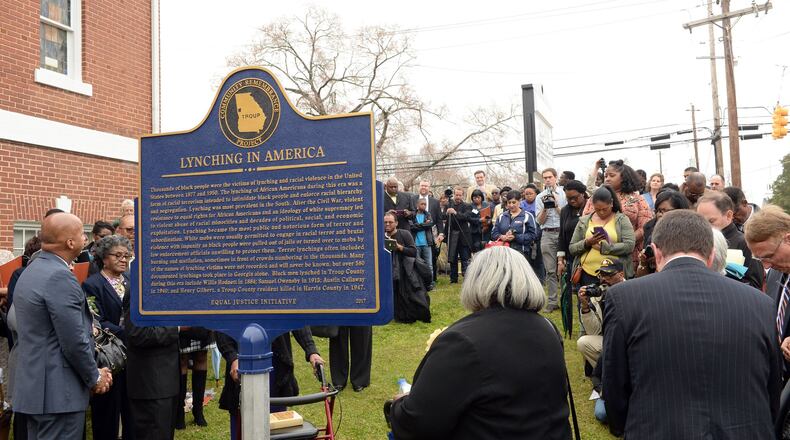Several years ago, Wesley Edwards and several residents of LaGrange sat in a small conference room at the police station. They had gathered during the holiday season to discuss a crime so horrific Edwards struggled to accept that it had ever happened in the town where he grew up.
“Part of the emotional response to violence is to push it away. We had to not edit out the truth of the violence,” said Edwards, who is white. They debated over words. They held the local police chief to the fire, asking if he planned to apologize for the lynching. It was a heavy subject that meant a lot to people in the community, and they all knew they needed to get it right. “You are writing by committee, you have a very tight word count and you are writing about a very difficult thing. It was stressful,” Edwards said.
Easily recognized by their shape and distinctive lettering, historical markers seem simple enough. Those who stop to read the stories describing people and events of the past may not consider how those stories get written. As many Americans continue to challenge traditional views of history, historical markers have assumed a prominent role in the nation’s culture wars, and ideas about who should be writing them seem to be changing.
“There is a new excitement surrounding these things,” said David Mitchell, director of operations for the Atlanta Preservation Center. “People are reading them and approving and disapproving of what the text says. I doubt anyone thought that in 2018 they would be under the scrutiny they are now.”
A more inclusive process
Cities and states nationwide are re-examining their approach to creating historical markers by focusing on underrepresented stories. The Georgia Historical Society, which oversees the official state marker program, introduced several special initiatives to develop markers that offer more inclusive views of state history. Last month, city officials in Atlanta shared plans to use a form of historical markers to bring deeper understanding to Confederate monuments instead of removing them, which would violate state law.
Depending on the subject, the process of writing these markers can take many months, require multiple drafts and involve a consortium of people weighing in on the words being used. The group that worked on the marker dedicated to Callaway's story was multiage and multiracial, comprised of the community group that Edwards co-chairs, the mayor, the pastor of the church where the marker was placed, the Equal Justice Initiative — an organization that has its own historical marker program to highlight lynchings in America, distant relatives of Callaway, the head of the local NAACP, and the police chief among others.
Edwards recalls that not a single word they used on the marker to describe the lynching and the subsequent apology from town officials was taken lightly. “Every word you choose has a tone or meaning or connotation, and that is why we were trying to share that text with a lot of different people in the room and out of the room,” Edwards said.
Only in recent years have historical markers begun to embrace a range of narratives, said Kevin Levin, a Civil War historian based in Boston. "We now have people taking part in this process who never were able to lay claim to a historic site. Who gets to tell those stories is a huge responsibility, and I think we are now in a place where we are more willing to have those conversations," he said.
A surge in interest
Historical markers first began appearing in Georgia in the 1930s as part of the Works Progress Administration, said Mitchell. In the early 1950s, the state launched a formal marker program in large part focused on the 100th anniversary of the Civil War. These would become the most recognized style of historical markers — the square-shaped aluminum signs mounted on posts with an average of 120-150 words of text. Most of the early markers placed by the state were singularly focused on traditional Civil War narratives surrounding troop movement, battles and top military leaders. At the time, they were a draw for tourists.
In 1998, the Georgia Historical Society (GHS) took responsibility for erecting new markers while the state maintained about 2,000 existing markers. GHS has erected about 250 new markers since taking over the program.
In recent years, projects have included markers created for the 150th anniversary of the Civil War that were designed to fill gaps in the traditional narrative. In 2014, GHS introduced a special initiative to install Civil Rights Trail markers and markers dedicated to Georgia-based businesses. The following year, they also took over maintenance of all markers in the state. From 2014 to the present, 19 markers detailing moments in the civil rights movement — the first of which documented the Atlanta Student Movement — were erected to join more than 20 older markers that explored the fight for civil and human rights.
In the past five years, applications for historical markers to GHS jumped from nine per year to 30 per year, said Christy Crisp, director of programs for GHS. While part of that growth can be attributed to the improved economy, it also speaks to the desire for a broader representation of history.
“We really started to see a resurgence when the Civil Rights Trail markers began going in a few years ago. Putting those in some of the communities inspired others to come with their own stories that are out of the mainstream,” Crisp said.
Applications are completed online and must be sponsored by an organization that pledges to cover $2,500 of the cost. The total cost of a marker can run in excess of $5,000, Crisp said. It takes GHS about six to 12 months from writing and reviewing the text to erect a finished marker.
GHS recently approved a marker sponsored by the Lee County Board of Education, specifically an AP history teacher and class, that will commemorate the Girls of Leesburg Stockade, the dozens of African-American girls ages 13-15 who were held in a stockade for two months in 1963 for participating in a demonstration in Americus. The marker should be dedicated in fall 2019, Crisp said.
With history, emotions collide
Historical markers are an important form of validation for communities, individuals and their experiences, and getting it right is a big responsibility. “It is a statement that something about your own identity matters,” Levin said. But even at their best, historical markers mostly tell us that history is complex, he said.
Last month, the Atlanta City Council joined several other cities around the country with plans for using historical markers to add context to Confederate monuments. Levin believes Georgia is a good test case for how those markers should be written, given the response when GHS corrected or introduced new markers to honor the 150th anniversary of the Civil War.
Several markers documenting Sherman’s “March to the Sea” corrected the Lost Cause narrative, which minimizes the role slavery played in the outbreak of the Civil War. One of the markers was erected at the Carter Center, but as W. Todd Groce, CEO of GHS, wrote in an essay featured in Levin’s book, “Interpreting the Civil War at Museums and Historic Sites,” former President Jimmy Carter sent a letter to GHS “demanding the marker be removed or re-written to reflect a more traditional Lost Cause interpretation.” The marker was relocated from the Carter Center to North Avenue and Moreland.
Levin was surprised by Carter’s response, but the reaction seemed to demonstrate how deeply our memory of history is rooted in emotion. It raised the question of how much authority the public is willing to give historians when their words clash with our sentiments.
When Marcy Breffle sat down to draft the text for one of the markers that will accompany the Confederate monuments at Oakland Cemetery, she went directly to the primary source — the meeting minutes of the Atlanta Ladies Memorial Association, which commissioned the Atlanta Lion Memorial to the Unknown Confederate Dead. Her draft wording will be circulated to a series of scholars, academics and others in the community before the markers are completed.
“It is very hard to have a completely neutral point of view. That is why when you involve multiple people in the process, you are getting different sides of the story. You can find something in the middle while making sure we are recognizing voices or history that may have been marginalized or silenced over time,” Breffle said.
Still, Levin cautions against viewing historical markers as the solution to controversy. “There is a place for historical markers. They have a job to do, but let’s be clear about the limits of that job,” he said. “How we think about the past really does tell us something about what kind of society we are now, whose stories matter and perhaps the direction we are headed. The question about what goes on markers is part of a much larger discussion we are having about what it means to be an American.”
A GROWTH IN MARKERS
In 2014, the Georgia Historical Society introduced the Civil Rights Trail and the Business History Initiative, both designed to bring a broader range of narratives to historical markers in the state. They have erected 58 markers in the past five years, 32 of which fall under the two programs. In 2018, that included the following seven markers:
Civil Rights Trail
Carswell Grove Baptist Church — Jenkins County
Freedom Alley and City Hall — Dougherty County
Louis B. Toomer — Chatham County
Business History Initiative
CNN — Fulton County
Genuine Parts — Fulton County
Georgia Dome — Fulton County
TSYS (Total Systems Services Inc.) — Muscogee County
About the Author
The Latest
Featured






